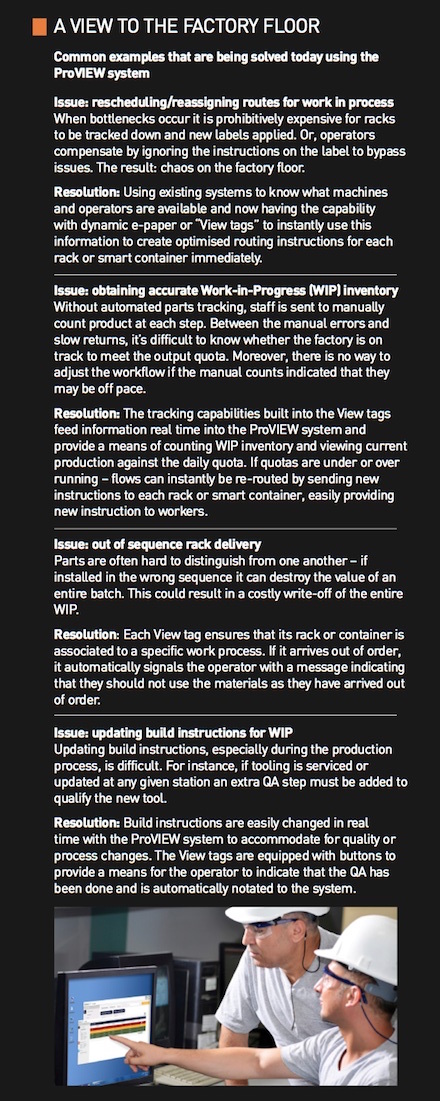
Manufacturing is changing, and paper labels can no longer keep up with the complexity of processes. What’s required is an optimal flexibility and quality assurance

According to the National Automobile Dealers Association, the 2015 model year brought 57 all-new or heavily revised versions to market (both domestic and import), which is significantly more than in any year since the last peak of 66 in 2007, and the third-highest total in the past 20 years.
With technology and customisation trends expanding, it’s easy to imagine that customers could soon be ordering a new car right from the comfort of their living room, on their smartphone. A factory then gets the message, immediately starts building it and the customer can track its progress – right from their smart phone, in real time.
The automotive industry is under pressure to deliver new or freshened models, with even more options, at an accelerated rate. Critical factors to success are the opportunity to expand market share within various segments by ensuring products are meeting and exceeding customer requirements.
It’s easy to see why other software or auto identification systems have been unsuccessful versus traditional, paper-based labels to date: paper is reliable, visual and familiar to the workforce. However, it is highly inflexible. Once the paper label is placed onto a container and launched into the process, its instructions or trajectory cannot be changed without a significant amount of human resources or other costly manual work-arounds.
“We’ve been in factories where containers were pulled off the line and were sitting for literally days or sometimes longer because no one knew what to do with them,” said George Daddis, CEO of Omni-ID.
Enter the IIoT and smart containers
The Industrial Internet of Things has been a key enabler for new technologies like this new e-Paper display combined with micro RF and other smart technologies. Wirelessly updated, the rugged e-paper screen is a direct replacement for paper labels placed on containers routing through the manufacturing process.
These 'smart containers' become immediately traceable (real time); accurate inventory counts are achieved with no manual counting.

Additionally, the screens can be changed dynamically, allowing operators to receive new instructions in real time for light-speed corrections or process exception handling. These e-paper or View tags fit seamlessly into the existing process, with a multitude of additional benefits that paper simply cannot provide.
This system is the first of its kind to provide paperless, wireless, material-flow management along with end-to-end process visibility. The big differentiator, this system (called ProVIEW), also provides a complete two-way feedback loop – the tags tell the operators what to do with them, operators execute instructions and interact with the system for confirmation of action or changes to the 'as-built' records with the simple push of a button.
All of the actions are tracked and stored within the system. Every rack, item, container on the factory floor is tracked with location, state and condition – which can be dynamically changed at any time to accommodate a workflow change.
Repurposing some material for another part of the line or staging it to balance flow? No problem. Think about a quality hold appearing immediately on a batch of containers needing to be quarantined through the plant. Those quarantined containers also have memory and can tell you their history, creation date of contents, which operator worked on them, time in inventory, temperatures experienced and many other really smart things. How about a container displaying if it is full or empty so you don’t have to open it to find out? What if the container told your worker where it was supposed to be and when it should be taken there?
In most factories, the scheduling team meets in the mornings to determine the demand for the day and create the necessary jobs and output. The schedule is committed to hundreds of paper labels and manually affixed to the racks of materials used for the day – and the process begins. If something goes awry, new labels need to be reprinted and manually sent out onto the floor, resulting in process bottlenecks with no way to quickly reroute materials.
Additional operations traditionally handled by paper labels such as parts replenishment and asset management are all possible using the ProVIEW system. One client, Robert Hyden, Detroit Diesel’s IT Manager, said: “Unlike paper and other traditional electronic tagging solutions, ProVIEW is an IoT solution that gives us the ability to not only track our materials, but control the process flows. The process visibility and control that the system provides has created a number of efficiencies for us – not to mention the savings from the paper alone. We’re now expanding to several other manufacturing lines within our facility.”



































